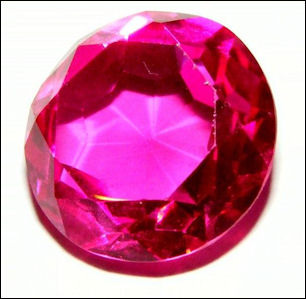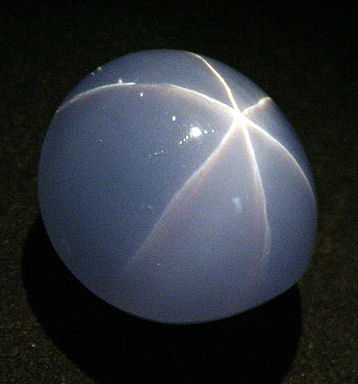RUBIES
ruby Rubies are the rarest and most valuable gem stones. They and their sister gems, sapphires, account for more than half the world's trade in colored stones. Rubies and sapphires are the second hardest gemstones after diamonds. They are variations of the mineral corundum, which is also used in sandpaper. [Source: Fred Ward, National Geographic, October 1991 [╔];
Rubies and sapphires are different colors of corundum, the crystalline form of aluminum oxide. Pure aluminum oxide is colorless, but very minute amounts of trace elements can create a wide variety of colors. Iron produces both green and yellow. A combination of chromium and iron creates orange. A combination of titanium and iron produces blue. A little bit of chromium causes pink. These are all sapphires. Rubies are corundum crystals that have enough chromium in them to be red. Star sapphires are sapphires with three sets of inclusions in different directions that produce the effect known as asterism — light reflected in intersecting bands.
Before diamonds rose in prominence, rubies were the most desired of all gem stones. European kings, Middle Eastern sultans and Indian maharajas all sought them. Arabian Nights described a magical valley where they were produced that was guarded by huge carnivorous birds called rocs. Treasure hunters threw meat to the birds, who placed the rubies of cliffs. When the treasure seekers tried to collect them with the birds often ate them.
In the old days any red gem was referred to as a ruby. These included garnets, spinels, tourmalines and true rubies. Gemologist Fred Ward wrote in National Geographic, "When biblical authors wrote that wisdom 'is more precious than rubies' or that a virtuous woman's 'price is far above rubies,' they probably were referring to carbuncles, a term for any crystals the color of glowing embers. Eleventh century Arabs used weight to differentiate rubies from less valuables red spinels. Yet medieval kings often believed their spinels were rubies."╔
Websites and Resources on Rubies: Wikipedia article on rubies Wikipedia ;
Websites and Resources on Gems: All About Gemstones allaboutgemstones.com ; Minerals and Gemstone Kingdom minerals.net ; International Gem Society gemsociety.org ; Wikipedia article Wikipedia ; Gemstones Guide gemstones-guide.com ; Gemological Institute of America gia.edu ; Mineralogy Database webmineral.com ;
Gems and Birthstones
Most gems are crystals formed by the cooling of hot gases, solutions and melts deep inside the earth. When excited atoms lose energy from cooling they form a lattice, typical of crystals. The natural laws that create gems are the same as those that create snowflakes and salt, except that tremendous pressures and temperatures are needed. Diamonds can only form at depths of 100 miles or more below the earth's surface where pressures are a million pounds per square inch and temperatures are above 2,500̊F.╿
Gems are classified as precious, semiprecious and ornamental stones. The size and weight of many gem is measured in carats. Carat is an ancient term which denotes the uniform weight of a carob seed — 1/142 of an ounce, 1/5 of a gram, or 200 milligrams. The value of a gem is often determined more by the quality of the stone and lack of imperfections than by size. Cut is term that describes the quality as well as shape of a gem. A loupe is a one-eyed lenses used by jewelers to examines gems closely.
Ancient man wore different kinds of stones as ornaments and jewelry. There is evidence of trade of exotic stones in Europe as far back as 28,000 B.C. Historical record from India in 300 B.C. describe the mining of moonstones, sapphires, diamonds, emeralds, garnets and agates.
These days all gems are tampered with to some degree. Rubies and sapphires are heated to change their color. A clear topaz can be transformed into a blue one with a dose of radiation. And internal debris is removed from within diamonds with minuscule laser holes. It often very difficult for ordinary people to tell real gems from doctored ones from outright fakes. Glass and man-made zirconia are both passed of as rubies and sapphires.
Birthstones: 1) January: Garnet; 2) February: Amethyst; 3) March: Aquamarine; 4) April: Diamond; 5) May: Emerald; 6) June: Pearl of Alexandrine; 7) July: Ruby; 8) August: Peridot; 9) September: Sapphire; 10) October: Opal or Tourmaline; 11) November: Topaz; 12) December: Turquoise of Zircon.
Ruby and Sapphire Market
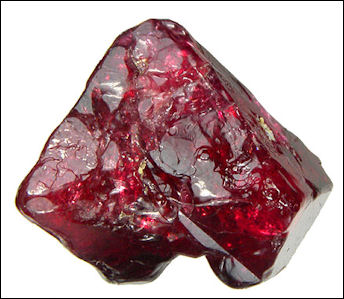
Spinel Little affected by weathering, rubies and sapphires are found frequently in alluvial deposits. Burma produces the most valuables gems; Sri Lanka perhaps the second best. Australia, Thailand, Cambodia, Tanzania, Kenya, Nigeria, and Montana also supply large numbers of stones and the most recent newcomers are China and Vietnam.╔
Australia's dark blue sapphires have traditionally dominated the low end market. The sapphire mine is Rubyvale is said to be the largest of its kind in the world. The 7,500 acre mine produces 12,500 carats a day, and it can keep churning them out at that rate for at least 16 more years.
Large gem quality rubies are 30 to 50 times more rare than diamonds. A ten-carat top-quality ruby can sell for more that US$200,000. A flawless white diamond the same size might bring a forth of that amount. The demand for colored gems soared in the 1980s and ruby prices soared higher and faster than the others.╔
Thais control the world sapphire and ruby market. Thai dealers, for example, buy Australian sapphires for an average 30 cents a carat. About 20 percent of it will be heat treated and cut, selling wholesale in the United States for $8 to $50 a carat."
Burmese Rubies
The Burmese call rubies "desire fulfilling stones." They believe that wearing them increase sex-appeal and guards against danger and ill-health. The largest cut ruby weighs 1184 carats. It was from Burma. The government own a 500 carat ruby giant. "We will not cut it, said one official, "It is a national treasure. [Source: Fred Ward, National Geographic, October 1991, ╔]
Officially all of Myanmar's gems belong to the state, which operates five-open pits and two underground ruby and sapphire mines. Theoretically all stones go to Rangoon, where first class stones are presented at an annual foreign-currency only sale. However, most gems are diverted by smugglers and who operate through 400 square miles of gem-bearing mountains. Its relatively easy to get the gems out of the country without the government knowing since it control few of the country's borders.╔
In an attempt to bring the ruby and sapphire trade out into the open, the Myanmar government now offers citizens two year leases on gem-bearing properties. The miners keep half of what they find and give the other half to the government who sell the gems and give the miners half. In the first seven months 200 operators reported producing 432,909 carats of stones.╔
The "annual gem emporium" in Rangoon is a six-day, invitation-only affair that takes places at the Inya Lake Hotel around the time of the Chinese New Year. Heavily armed guards watch the proceedings as buyers from around the rold examine precious stones set up on tables in the hotel and tents on the hotel grounds. Bids are written down on pieces of paper and deposited in a silver bowl at the front of the auction room. The atmosphere is surprisingly subdued, considering the sums of money that are at stake. Tea and sandwiches are served and buyers often doze off.
Mogok Ruby Mine in Myanmar
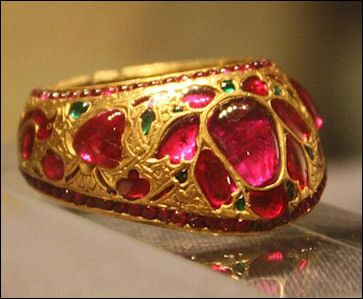
Vanda gold thumb ring The Mogok region north of Mandalay contains one of the world's richest ruby mines. While other Burmese cities use World War II jeeps for taxis, Mogok, a city of 100,000 people is a buzz with new Japanese cars and motorbikes. Most of the work is done by hand which entails sifting through mounds of gravel in pools of muddy water. Large "star rubies" that are pigeon red in color are found this way. ╔
Rubies are said to have been mined in the Mogok Valley since A.D. 500. "No other gem source is so steeped in mystery and lore," says Ward about the fabled Mogok Stone Tract. "Many of the spectacular rubies collected by India's maharajahs, Persia's shahs and Turkey's sultans originated at Mogok. This region produces the storied "pigeon's blood" rubies, a unique red found in only a few gems a year. The distinctive glow , caused mainly by chromium's fluorescence, once inspired an old Thai trader to declare, “Asking to see the pigeon blood is like asking to see the face of God.”"╔
At the government mines high pressure hoses are used to flush away clay, dirt, and sand, leaving gravel and rough gemstones. The materials are trapped inside a wash box and when a log gate is open, the gravel and gems — mainly sapphires — tumble over jigs. Vibrating racks are then used to separate the heavier sapphires from the smaller ones.╔
Sri Lanka Rubies and Sapphires
Sri Lanka produces some the finest cat eye sapphires and rubies in the world as well as diamonds and pink, orange, yellow, white and honey-colored sapphires, alexandrines, aquamarines, tourmalines, spinel, topaz, and garnets. No red rubies are found in Sri Lanka but pink ones are. They are also called pinks sapphires.
Sri Lanka's mines are believed to have been the source of the jewels that Solomon gave the Queen of Sheba. In “Arabian Nights”, Sinbad said he visited the King of Ceylon "on the battlements of whose palace are a thousand jewels."
Chinese traders described Sri Lankan gems the crystallized tears of the first men. And Marco Polo wrote of "a flawless ruby the size of man arm” and "sapphires, topazes, amethysts, garnets" after his visit to Ceylon in 1292.
The famous but misnamed "Star of India" sapphire on display at the New York Museum of Natural History was unearthed in Sri Lanka. The 400-carat blue sapphire called the “Blue Belle” which adorns the British crown is also from Sri Lanka.
"Sri Lanka's southern half two-thirds," says Ward, "has been blessed with a profusion of colored gemstones and some diamonds, all washed down from a core of central mountains. People find gems in their yards and fields, in streams, even on walkways after it rains.╔
Sri Lankan Sapphire Mining
Star of India gem The Sri Lankan gem industry has advantages over the gem industries in other nations because most the gems are found in shallow pits not open mines. What’s more, a variety of different gem stones can be found in one pit. A typical gem pit in Sri Lanka is 45-feet deep and 15 feet square, with several stygian tunnels angling from it.
Ratnapura is one of Sri Lanka's most famous gem producing areas. The gems are found in gravel at the bottom of mud pits as deep as 60 feet below the surrounding rice paddies. The gravel is hoisted out of the pits by the bucketful and taken to a nearby stream were the stones are washed and examined to see if any of them are gems.
Prospectors look for seams of gravel-bearing stratum likely to hold gem stones, which are usually located in lowland areas such as river beds or valley bottoms. Illegal miners often dig pits in the jungle and then cover them with forest materials to avoid detection. These pits sometimes inadvertently trap or injure elephants or other wild animals.
Gem miners sell their stones to dealers, who sell the rough stones to cutter-polishers, who in turn sells the cut stones to wholesaler-retailers. Descendants of Muslim gem traders cut and polish the stones. The dealer-collectors are the ones who make the biggest profits. Cutters and polishers often use primitives tools and methods.
Sri Lankan Sapphire Miners
Sri Lankan miners ply their trade by digging pits, climbing through tunnels and scooping up gem-bearing gravel by hand much as their ancestors did thousands of years ago. The gravel is loaded in wicker baskets and cranked to the surface. The gemstones are sifted from the gravel by roiling the baskets in a pond like 49ers panning gold. Underground some miners still work by candlelight.
The loin-clothed miner usually work in teams, with one group digging out the seam; someone operating a pump to keep water out of the pit; someone washing off the stones; and skilled gem finders looking through the gravel for gem stones. There is often someone who finances the whole operation. If gems are found the profits are divided among all those involved in the operation.
Many miners work seven days a week from dawn to dusk and sometimes go months without finding any valuable stones. One miner told Robert Paul Jordan of National Geographic, "I don't get tired. I'm used to it. In a week you may find something. Or, four...five...six months go by and you still have nothing.
Ruby and Sapphire Business in Thailand
In the 1980s and 90s Thai gem dealers for all intents and purposes had a monopoly on the ruby and sapphire market. "In addition to cutting and marketing Myanmar's smuggled goods and their own rubies and sapphires, " wrote Ward, "Thais pay off both the Khmer Rouge and the Thai Army to allow them to mine in Cambodia, Exclusive contracts at first guaranteed that Thai dealers got Vietnam's new rubies. Traveling Thai buyers scoop up Australia's sapphires, either on the spot or by attempting to buy a miner's entire annual production. Long-standing contracts ensure that Sri Lanka's gems end up with the Thais. Only the miners in Montana resist exporting their sapphires."╔
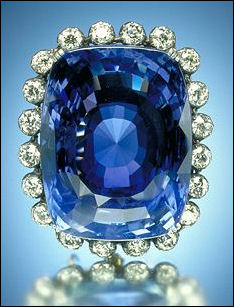
Logan sapphire Most of the gem factories are located in Bangkok and Chanthaburi. Sometimes the gems are sawed into angular geometric shapes but usually they are shaped into round, oval or octagonal shapes with diamond impregnated grinding wheels. They are then polished with extraordinarily fine diamond grit.╔
Thai cutters charge between 30 cents and two dollars a carat to process stones. Workers earn two to five dollars a day. Collectively they cut rubies and sapphires worth more than half a billion dollars a year.╔
To reach their position of dominance Ward wrote: "The Thais saw an opportunity and made the most of it. Gem dealers persuaded the government to drop important and export taxes to create a climate of growth. Then they systematically built a market to supply global buyers with a huge variety of polished stones and finished jewelry. Combined with luxury hotels and a nonstop entertainment district catering to very whim, the selling package is irresistible."╔
The Thais are not the most up front and honorable gem merchants that ever walked the planet. Some dealers label their Vietnamese stones as Burmese "ensuring and instant”and unwarranted “profit.” Other convinced the Sri Lankans their colorless sapphires were worthless and bought the stones for 10 to 30 cents a carat and then heated them to brilliant blues and yellows that sold for thousands of dollars.╔ "
A Thai gem dealer told a socialist Tanzanian officials who was worried about outsiders profiting from his country's rubies and sapphires: "We never exploit the poor in the gem trade. We only exploit the rich.╔
Thais and the Sri Lankan Sapphire Market
In the 1980s Thai gem dealers convinced the Sri Lankans their colorless sapphires were worthless and bought the stones for 10 to 30 cents a carat. Later they heated the same stones to brilliant blues and yellows and sold them sold for thousands of dollars.╔
Later Sri Lanka withdrew Thai dealers exclusive buyer status for sapphires. One Sri Lankan official told National Geographic: "We have to get control of our own gems. That means buying furnaces and training people to heat, cut, and sell gems here instead of letting the Thais make all the value added profits." Such independence will prove very difficult as along as the Thais control the market.╔
A few years ago, according to one story, a prominent Bangkok gem dealer announced that he intended to heat treat sapphires in Sri Lanka. After learning that jealous dealers had taken out a contract on his life, he quickly dropped the project.╔
When the owner of an Australian mine said he wanted to open a cutting operation in Sri Lanka, the Thai buyers dropped the prices they paid for his sapphires 30 percent overnight. "I've been mining sapphires for 14 years," he said, and I'm almost out of business."╔
Ruby and Sapphire Enhancement

Star sapphire
Emeralds, rubies and sapphires are often "enhanced" with heat, lasers and fillers. It is very difficult for tourist to tell real gems from doctored ones from outright fakes. Glass and man-made zirconia are both passed off as rubies and sapphires. Even royalty are some times get taken. The 170-carat Black Prince's Ruby in British Crown Jewels, for example, is actually a spinel.╔
To produce clean, marketable gems, almost all rubies and sapphires are heated to enhance their clarity and color. The same is true with other colored stones, and the practice has been around since Roman times. Heating sapphires, for example, redissolves the titanium, which reacts with iron to makes gem look blue. The motto of one heat-treater is, "We finish what nature forgot."╔
Today the coloring market is so sophisticated that relatively worthless and off-color sapphires are tuned into valuable blue stones by adding iron and titanium and cooking the stones for 600 hours near sapphire's 2050̊F melting point. The outer .4 millimeters of the stone turns blue and workers in the gem factories are careful not to polish through the thin blue layer. The practice is not popular among dealers who sell real sapphires. One practitioner of this form of sapphire enhancement has received ten death threats.╔
While naturally colored diamonds cost more than more than treated ones, natural rubies and sapphires actually cost less. Says one heat treater. "Turning Sri Lankan geuda blue, which [gen dealers] brag about, is so easy it can almost be done by tossing it into a fireplace."╔
Ruby and Sapphire Records
According to the Guinness Book of Records, the largest ruby is the Eminent Star Ruby. Believed to be of Indian origin, it is 6,465 carats. In Burma there is an uncut ruby that weighs 1184 carats.
According to the Guinness Book of Records, the highest price paid for a ruby ring emerald was $227,300 for a 15.97 carat ruby and sold by Sotheby's in New York in October 1988.
According to the Guinness Book of Records, the largest star sapphire is the 9,719.5-carat Lone Star, cut in London in November 1989; and the highest price paid for a sapphire was $2,791,000 for a 62.02-carat step cut sapphire on a sapphire and diamond ring and sold by Sotheby's in St. Moritz in February 1988. A 2,302-carat stone was found in Anakie, Queensland in 1935.
Synthetic Rubies and Sapphires
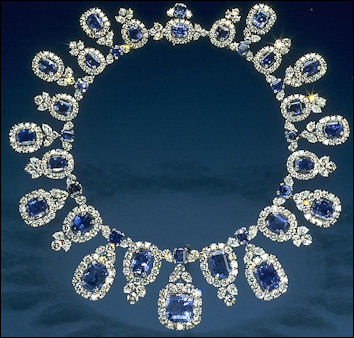
Hall Sapphire and Diamond Necklace Rubies, emeralds and sapphires can all be produced in the laboratory. Sometimes the synthetic versions look more authentic and have fewer flaws than the stones mined from the ground. Synthetic rubies and sapphires are manufactured and have a number of practical applications.
Sapphire crystals are used to make scratch-proof watch faces and ball bearings that are harder than steel. Synthetic ruby or sapphires columns are at the heart of almost every laser. The latest missiles have sapphire nose cones that transmit electronic signals, but don't deteriorate, even when racing through a sandstorm. The checkout scanners at grocery stores have both a ruby laser to read the bar-code prices and a sapphire coating on the glass to keep it from being scratched.╔
Synthetic rubies can be manufactured several ways, all of which attempt to duplicate and reproduce the conditions inside the earth that produces natural stones. In one method, ruby seed crystals are added to a glowing mixture of 1000̊F aluminum oxide and chromium and ruby crystals grow on the seeds of almost a year. These sell for US$25 to $450 a carat wholesale. A similar method grows the crystals in three months on the wall of platinum crucibles without using a seed.╔
Hrand Djévahirdjian S.A. in Switzerland, the world largest producer of synthetic gems, create rubies and sapphires by dropping aluminum oxide powder through a flame. To get red rubies chromium oxide is added; for blue, titanium and iron. Yellow is generated with nickel, and green with cobalt. The powder lands on a seed crystal and solidifies in five and half hours into a cylinder about the size of a roll of pennies.╔
Image Sources: Wikimedia Commons
Text Sources: Mostly National Geographic articles. Also the New York Times, Washington Post, Los Angeles Times, Wikipedia, The Independent, Times of London, The New Yorker, Time, Newsweek, Reuters, AP, AFP, Lonely Planet Guides, Compton’s Encyclopedia and various books and other publications.
Last updated March 2011

